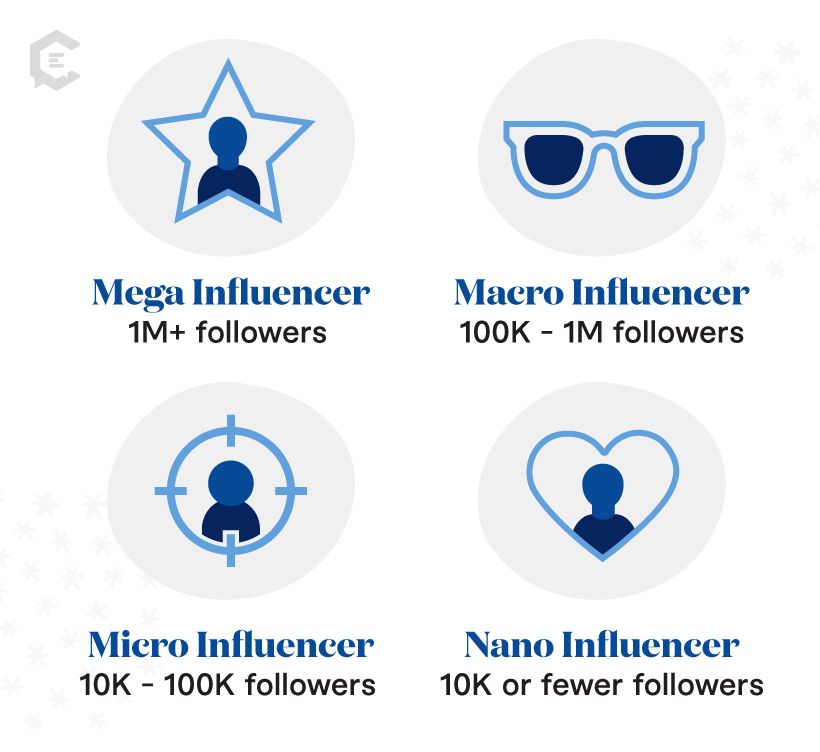What is influencer marketing?
Influencer marketing is a content marketing strategy component that involves outsourcing content promoting your product or service to creators with a significant and engaged social media following.
The type of content and campaign can vary just as widely as the size of the social media following you’re looking to leverage. Unlike hiring a spokesperson to speak to your audience (think: Flo from Progressive), influencer marketing relies on tapping into someone else’s existing audience and allowing them to use their brand voice to influence their audience to hear your message.

Why is influencer marketing important?
As necessary as marketing is for any product or service to build awareness, people don’t like to be sold to. People do, however, love to hear recommendations about products and services from people they trust, admire, and/or aspire to live like. Imagine your best friend telling you about how great this new product is they just tried. Wouldn’t you be curious to try it, too?
That’s influencer marketing.
Why else is influencer marketing important?
- Influencers are everywhere. No matter what platform your audience is using, established influencers are reaching your target audience with their content
- Influencers come with built-in trust and engagement. Sixty-one percent of social media users say they interact with an influencer at least once daily, with another 35 percent saying they interact multiple times daily
- Influencers are already reaching your target audience, so the leads they generate for you are of higher quality
What qualifies as an “influencer”?
In the early days of social media, influencers were identified solely by the size of their following. Today, however, influencers with huge followings are akin to celebrities (and many of them actually are celebrities), which means that depending on your brand and your budget, they may be out of reach.
The good news is that the ” influencer ” category has since been broken down into tiers, making influencer marketing accessible to any content team, regardless of budget. The rule of thumb is:
- Mega influencer: 1M+ followers
- Macro influencer: 100K – 1M followers
- Micro influencer: 10K – 100K followers
- Nano influencer: 10K or fewer followers
Isn’t influencer marketing expensive?
Not necessarily! If you’re looking to tap into the audience of a certain family of K names, then yes, that will likely be a costly endeavor. However, the benefits of utilizing these lower-tier influencers include much more cost-effective campaigns and a highly targeted, engaged audience.
Let’s look at some numbers:
- Brands prefer to work with small (nano – 39 percent and micro – 30 percent) influencers instead of expensive macro-influencers (19 percent) and celebrities (12 percent)
- On Instagram, nano-influencers charge between $10-100 per post; micro-influencers charge between $100-500 per post; macro-influencers charge between $5,000-$10,000 per post
- On TikTok, nano-influencers charge between $5-$25 per post; micro-influencers charge between $25-$125; macro-influencers charge between $1,250-$2,500
How to Get Started with an Influencer Marketing Strategy
First and foremost, remember that influencer marketing is just one part of your overall content strategy. Just like everything else, it goes hand-in-hand with what’s already working to reach your target audience with consistent brand messaging.
With that in mind, you’ll want to keep these best practices in mind when building out your influencer marketing strategy:
- Understand platform demographics. Instagram, Snapchat, YouTube, and TikTok have different user bases. Don’t chase the new and trending platform if it’s not the right fit for your brand. How old is your target demographic? Where are they likely to spend their time?
- Identify your audience. This is crucial to remember when engaging influencers, especially at the micro and nano levels, where you’re concentrating on a much more targeted group. Working with the wrong influencer for your audience could mean stifling your sales goals and loss of public trust.
- Be clear about your goals. This will not only help you identify the right influencer but also ensure their services are aligned to match.
- Ensure transparency. Influencers understand that the key to their success (and, in turn, yours) is authenticity in their content. That’s what resonates with their audience, and any content that doesn’t ring true will turn off their audience. Work together with your influencers to create a campaign that’s engaging and resonates with their audience.
- Try micro or nano influencers. Their audiences may be smaller but are typically more passionate and engaged. These tiers of influencers are also more cost-effective! If you’re just getting started with influencer marketing, you can stretch your dollar further here.
ClearVoice Can Help with Your Influencer Marketing
Whether it’s helping you identify the right niches for your brand message or constructing an influencer marketing campaign itself, we want to be your content partner. Talk to a content specialist today and be one step closer to reaching your target audience with influencer marketing.







